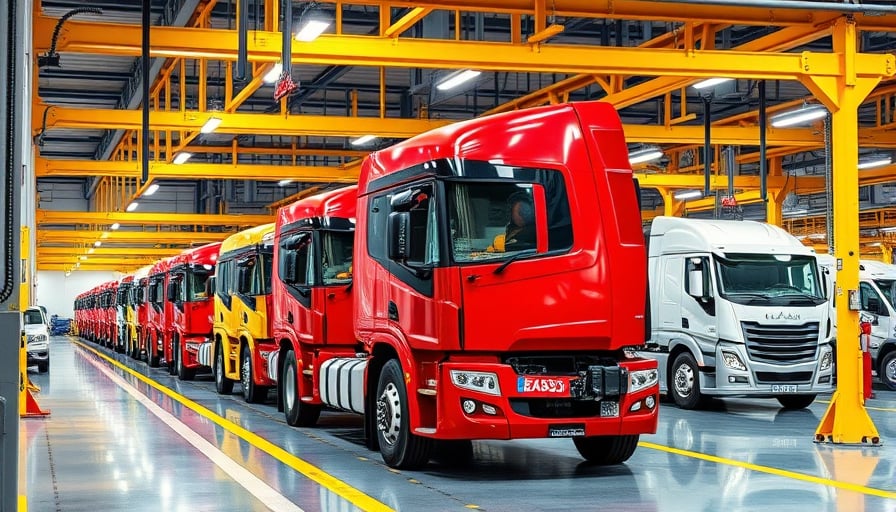Daimler Truck Holding AG Faces Market‑Driven Volatility Amidst a Resilient Production Base
Daimler Truck Holding AG, the German‑based commercial‑vehicle manufacturer, has experienced a recent dip in its share price, falling approximately 1 % on the last trading day. The company’s market capitalisation hovers near €26.7 billion, positioning it as the 36th largest constituent of the DAX index. While the share price has risen about 30 % over the past three years, the short‑term decline reflects broader market dynamics and sector‑specific pressures rather than a fundamental shift in the firm’s manufacturing performance.
Production‑Scale Operations and Productivity Metrics
Daimler Truck operates a network of 23 production sites across Europe and the United States. The company’s current manufacturing mix emphasises modular platform engineering, which enables the rapid integration of electrified powertrains and autonomous‑driving hardware across its heavy‑truck and bus portfolios. Recent data indicate that the plant utilisation rate averages 96 % in the core facilities, with a turn‑over ratio (units produced per employee) exceeding the industry benchmark of 1.2 units per worker.
Key productivity drivers include:
- Automation of the assembly line: The introduction of collaborative robots (cobots) for wheel‑assembly and body‑shop welding has cut cycle times by 18 % on the high‑capacity lines.
- Digital twins in logistics: Real‑time simulation of supply‑chain flows reduces inbound delays by 12 % and optimises spare‑part inventory levels.
- Energy‑management systems: Integration of variable‑frequency drives and smart HVAC controls has reduced plant energy consumption by 9 % per tonne of output.
These metrics demonstrate that Daimler Truck’s manufacturing base remains robust, supporting stable production output even as capital‑expenditure decisions adapt to market signals.
Technological Innovation in Heavy Industry
The company’s research and development pipeline is anchored on three pillars: electrification, autonomous technology, and lightweight materials.
Electrification
Daimler Truck’s battery‑electric chassis (the eActros platform) now utilises a 200 kWh lithium‑ion pack that delivers a 300 km range under the European highway regime. The battery chemistry shift to nickel‑cobalt‑aluminum (NCA) alloys has improved energy density by 15 % compared to earlier chemistries, enabling lighter packaging and higher payload capacity.Autonomous Driving
Leveraging a proprietary machine‑learning stack, the company’s SmartDrive™ suite offers Level 4 autonomy in urban freight corridors. The system incorporates high‑definition LiDAR and radar arrays, coupled with edge‑computing modules that process sensor data with sub‑millisecond latency, ensuring regulatory compliance in the EU’s stringent safety framework.Lightweight Materials
Recent collaboration with aerospace supplier AirMet has introduced high‑strength aluminium‑copper alloys into the frame architecture, reducing structural mass by 6 % without compromising crash‑worthiness. The alloys also provide improved corrosion resistance, extending maintenance intervals.
These innovations are reflected in the company’s Q3 earnings, where profit margins edged upward despite volatile raw‑material costs. The competitive advantage derived from these technologies is a likely catalyst for future capital‑investment allocations.
Capital‑Expenditure Trends and Economic Drivers
Capital expenditure (CapEx) for the heavy‑vehicle sector has surged by ~10 % YoY in 2024, driven by:
- Regulatory pressure: The EU’s 2025 CO₂ emission ceiling for commercial vehicles has prompted manufacturers to invest in low‑emission propulsion systems and efficient drivetrain components.
- Infrastructure spending: European Union and national budgets earmarked €200 billion for logistics‑friendly infrastructure (e.g., electric‑charging hubs for trucks) create demand for high‑performance freight vehicles.
- Supply‑chain resilience: Ongoing semiconductor shortages have incentivised manufacturers to diversify component sourcing and adopt in‑house semiconductor design capabilities.
Daimler Truck’s recent CapEx allocation reflects these trends: a €1.2 billion investment in a new battery‑manufacturing facility and €300 million in autonomous‑driving sensor development. These outlays are expected to be amortised over 10 years, aligning with the company’s long‑term strategic roadmap.
Comparative Outlook: Daimler Truck vs. Traton
While Daimler Truck’s share price declined modestly, its rival Traton SE recorded a 3.8 % share price uptick, narrowing the valuation gap. Traton’s superior third‑quarter margins—stemming from higher operating leverage and a diversified product mix—have attracted investor confidence. Nevertheless, Daimler Truck’s technological initiatives position it to capture premium pricing in the electrified segment, potentially offsetting short‑term market volatility.
Supply‑Chain and Regulatory Implications
- Supplier diversification: Both Daimler Truck and Traton are reducing exposure to single‑source suppliers by engaging multiple tier‑2 partners for critical components such as electric motors and battery cells.
- Compliance frameworks: The EU’s Artificial‑Intelligence Act imposes risk‑assessment protocols on autonomous systems; Daimler Truck’s proactive certification process positions it favorably against compliance delays.
- Trade‑tension mitigation: The easing of US‑China trade friction has softened the cost pressure on semiconductor imports, indirectly benefiting production timelines.
Conclusion
Despite a recent share‑price decline influenced by broader market sentiment and a slightly weaker DAX index performance, Daimler Truck Holding AG maintains a strong manufacturing foundation underscored by high utilisation rates, cutting‑edge automation, and strategic technological investments. Capital‑expenditure decisions are shaped by regulatory mandates, infrastructure commitments, and supply‑chain resilience initiatives. The company’s continued focus on electrification, autonomous capability, and lightweight materials positions it to sustain growth momentum and defend its market share against rivals like Traton in the evolving landscape of heavy‑industry production.
